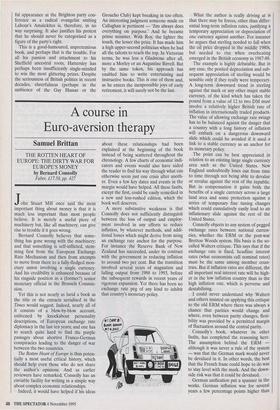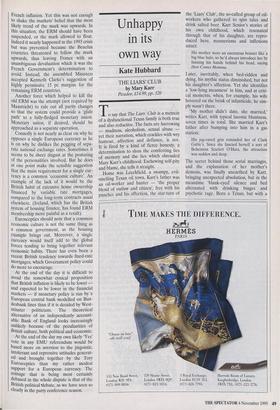A course in Euro-aversion therapy
Samuel Brittan
THE ROTTEN HEART OF EUROPE: THE DIRTY WAR FOR EUROPE'S MONEY by Bernard Connolly Faber, £17.50, pp. 427 John Stuart Mill once said the most important thing about money is that it is much less important than most people believe. It is merely a useful piece of machinery but, like all machinery, can give rise to trouble if it goes wrong.
Bernard Connolly believes that some- thing has gone wrong with the machinery; and that something is self-inflicted, stem- ming first from the European Exchange Rate Mechanism and then from attempts to move from there to a fully-fledged mon- etary union involving a single currency. And his credibility is enhanced because of his ringside position as a (former?) senior monetary official in the Brussels Commis- sion.
Yet this is not nearly as lurid- a book as the title or the extracts serialised in the Times would suggest. Indeed, nearly all of it consists of a blow-by-blow account, enlivened by knockabout personality descriptions, of European exchange rate diplomacy in the last ten years; and one has to search quite hard to find the purple passages about abortive Franco-German conspiracies leading to the danger of war between the two countries.
The Rotten Heart of Europe is thus poten- tially a most useful critical history, which should help even those who do not share the author's opinions. And as earlier reviewers have remarked, Connolly has an enviable facility for writing in a simple way about complex economic relationships.
Indeed, it would have helped if his ideas about these relationships had been explained at the beginning of the book instead of being scattered throughout the chronology. A few charts of economic indi- cators and events would also have aided the reader to find his way through what can otherwise seem just one crisis after anoth- er. Even a few key dates and events in the margin would have helped. All these faults, except the first, could be easily remedied in a new and less-rushed edition, which the book well deserves.
A more substantive weakness is that Connolly does not sufficiently distinguish between the loss of output and employ- ment involved in any efforts to reduce inflation, by whatever methods, and addi- tional losses which might derive from using an exchange rate anchor for the purpose. For instance the Reserve Bank of New Zealand has succeeded, under its contract with the government in reducing inflation to around two per cent. But the transition involved several years of stagnation and falling output from 1988 to 1993, before the subsequent rewards in recent years of vigorous expansion. Yet there has been no exchange rate peg of any kind to inhibit that country's monetary policy. What the author is really driving at is that there may be forces, other than differ- ential long-term inflation rates, justifying a temporary appreciation or depreciation of one currency against another. For instance he argues that sterling needed to fall when the oil price dropped in the middle 1980s, but needed to rise when overheating emerged in the British economy in 1987-88.
The example is highly debatable. But in any case, the posited depreciation and sub- sequent appreciation of sterling would be sensible only if they really were temporary. A long-term downward trend in sterling against the mark or any other major stable currency, of the kind which has taken the pound from a value of 12 to two DM must involve a relatively higher British rate of inflation in internationally traded products. The value of allowing exchange rate swings has to be balanced against the danger that a country with a long history of inflation will embark on a dangerous downward slide which could be avoided if it used a link to a stable currency as an anchor for its monetary policy.
The point can be best appreciated in relation to an existing large single currency area such as the United States. New England undoubtedly loses out from time to time through not being able to devalue or revalue against the rest of the republic. But in compensation it gains both the benefits of a single currency across a large land area and some protection against a series of temporary fine tuning changes which could cumulatively easily lead to an inflationary slide against the rest of the United States.
Connolly objects to any system of pegged exchange rates between national curren- cies, whether the ERM or the post-war Bretton Woods system. His basis is the so- called Walters critique. This says that if the exchange rate is fixed, headline interest rates (what economists call nominal rates) must be the same among member coun- tries. But if inflation rates are different, the all important real interest rate will be high- er in the low inflation country than in the high inflation one, which is perverse and destabilising.
I could never understand why Walters and others insisted on applying this critique to the old ERM where there was always a chance that parities would change and where, even between parity changes, flexi- bility was provided by a permitted margin of fluctuation around the central parity.
Connolly's book, whatever its other faults, has completed the reasoning here. The assumption behind the ERM although it was never a rule of the system — was that the German mark would never be devalued in it. In other words, the best that the French franc could hope to do was to stay level with the mark. And the down- side risk was that it could be devalued.
German unification put a spanner in the works. German inflation was for several years a few percentage points higher than French inflation. Yet this was not enough to shake the markets' belief that the most likely trend of the mark was upwards. In this situation, the ERM should have been suspended, or the mark allowed to float. Indeed it nearly happened in the 1993 crisis but was prevented because the Benelux countries threatened to follow the mark upwards, thus leaving France with an unambiguous devaluation which it was the French Government's determination to avoid. Instead, the assembled Ministers accepted Kenneth Clarke's suggestion of highly permissive 15 pc margins for the remaining ERM countries.
Another force which helped to kill the old ERM was the attempt (not required by Maastricht) to rule out all parity changes so that the system could provide a 'glide path' to a fully-fledged monetary union. Monetary union, if desired, should be approached as a separate operation.
Connolly is not nearly as clear on why he opposes a single European currency as he is on why he dislikes the pegging of sepa- rate national exchange rates. Sometimes it seems to be sheer disgust at the posturing of the personalities involved. But he does at one point make the sensible suggestion that the main requirement for a single cur- rency is a common 'economic culture'. An example of the lack of it would be the British habit of extensive home ownership financed by variable rate mortgages, compared to the long-term contracts usual elsewhere. (Ireland, which has the British system of housing finance, has found ERM membership more painful as a result).
Eurosceptics should note that a common economic culture is not the same thing as a common government, as the housing example brings out. Moreover, a single currency would itself add to the global forces tending to bring together relevant economic habits. There has even been a recent British tendency towards fixed-rate mortgages, which Government policy could do more to encourage.
At the end of the day it is difficult to avoid the somewhat cynical proposition that British inflation is likely to be lower and expected to be lower in the financial markets — if monetary policy is run by a European central bank modelled on Bun- desbank lines than if it is decided by West- minster politicians. The theoretical alternative of an independently account- able Bank of England looks increasingly unlikely because of the peculiarities of British culture, both political and economic.
At the end of the day my own likely 'Yes' vote in any EMU referendum would be based more on aversion to the jingoistic, intolerant and repressive attitudes generat- ed and brought together by the Tory Eurosceptics than my rather modest support for a European currency. The coinage that is being most certainly debased in the whole dispute is that of the British political 'debate, as we have seen so clearly in the party conference season.











































































 Previous page
Previous page